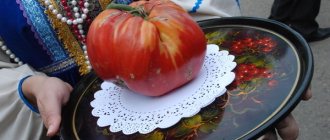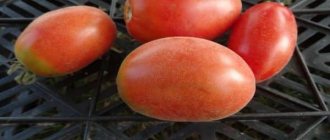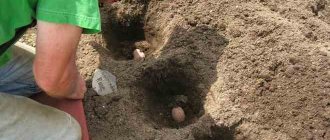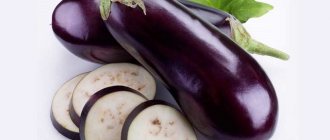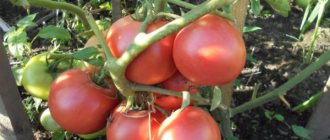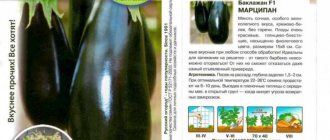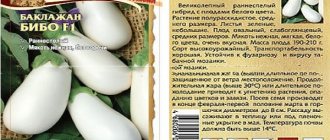The Japanese dwarf eggplant looks original and attractive. According to the characteristics of farmers, this variety is quite productive - many neatly shaped fruits set and ripen on small bushes.
| Origin | Landing location | Ripening period | Fruit color | Fruit weight | Fruit shape |
| Variety | Greenhouse | Early ripening | Violet | 240-310 g. | Round |
Description of the Japanese dwarf variety
Japanese dwarf is an early ripening variety recommended for growing indoors or directly in the beds. From the day the planting material is planted in the soil until the first wave of harvest is obtained, about 3 months pass. When grown in unfavorable cool conditions, this period will extend a little - the first fruits will ripen in 3.5-4 months.
The bushes of the variety are low, compact, rarely exceed 40 centimeters in greenhouse conditions. The leaves are large, semicircular. The stems are powerful and easily support the weight of the crop. The fruits are shaped a little like a pear and reach 20 centimeters in length. The weight is not impressive - only 300 grams.
The color of ripened fruits is dark purple, almost black. The pulp is light, pleasant to the taste, and does not have the bitterness characteristic of this culture. The fruits are used for various purposes - canned, frozen, used for main courses, salads.
Eggplant varieties for growing in Siberia
The main thing when growing eggplants for Siberia is the choice of variety. If you do not take into account winter heated greenhouses, where everything can ripen, only early or mid-ripening varieties should be grown in this climatic zone:
- “Almaz” is a mid-season variety; it takes 110-150 days from seeding to maturity. Plant height is 0.5 meters, fruits prefer the lower part of the plant. Their shape is cylindrical, 14-18 cm long, weighing up to 170 g, the color is dark purple. The flesh has a green tint and no bitterness. In Siberia it is available for cultivation using open ground technology.
- "Baltic" - mid-early, fruits from dark purple to black, white flesh.
- “Dwarf early 921” is known for its early ripening (no more than 110 days) and a large number of fruits. Planting height is up to 45 cm. Fruit formations are usually mounted low. Round or slightly pear-shaped. Young fruits are dark purple. In film greenhouses they produce up to 6 kg per bush. Open ground is allowed.
- “Swan” is mid-season, reaches technical ripeness in 100-110 days. The growth of the bush is up to 70 cm. The color of the fruit is snow-white at first, then turns yellow. Length 18-22 cm. Weight up to 250 g. Very delicate white pulp. For 1 sq. m you can find up to 18 kg of crop.
- “Matrosik” is an early ripening hybrid, the plant is tall - from 90 cm, the fruit formations are cylindrical in shape up to 25 cm in length. Pulp with a green tint without bitterness. It takes root equally well in open ground or in a greenhouse. The variety is immune to mosaic virus. 10 kg or more are collected from a square area.
- “Early ripening 148” - quickly ripening (up to 105 days), maximum growth of the bush is 55 cm. Pear-shaped, dark purple fruits at technical ripeness, weighing up to 200 g. 4-6 kg are collected from one square area.
- “Nutcracker” is a hybrid of the mid-early type. Ripens in 45 days. The growth of the bush is up to 80 cm. The fruits are round, dark purple in color, weighing up to 600 g. Fruits are formed along the entire trunk. On average they produce 5 kg per bush. Well stored and transported.
The best varieties of eggplant for growing in Siberia also include: “Donetsk 14”, “King of the Market F1”, “Beijing”, “Universal”, “Purple Dwarf”, “Black Beauty”, “Epic”. Choose the best, depending on the growing capabilities, taste and desired harvest volume.
It is undesirable to use seeds that are more than three years old for planting in Siberian conditions.
Characteristics of eggplant
Japanese dwarf is recommended for growing in regions with temperate and even cool climates. In warm regions, seedlings are planted in beds; in cool regions, you will have to use a greenhouse, otherwise you will not be able to get a harvest.
The peculiarity of the variety is the duration of flowering. If the weather permits, the fruits are harvested until the coldest weather. In winter heated greenhouses, you can get fresh eggplants to the table even on frosty days. Productivity – up to 3 kilograms per bush.
The value of the Japanese dwarf is its taste, small amount of seeds, and tender pulp.
But if the eggplant is red
For a vegetable grower, all plants are like children.
It doesn’t matter what race they are, what color they are, or what genes they have. They all need care and love
They may be weak from birth, strong in their genetic capabilities, or sickly due to poor acclimatization
Only the attention and love of their parents will make them healthy and happy in the future.
This is also the case with red eggplants, but this is Solanum aethiopicum. In other words, Ethiopian nightshade. These are the usual “blue” ones, but not eggplant-colored. Although nature created them red, they are the same eggplants, with all the nuances of their cultivation.
These plants are just as sissy as their purple counterparts. They love warmth, water and light in the same way. They love fertile soil and warm watering at the root. But they were not entirely successful in taste and yield. But how beautiful they are.
Features of growing seeds
To grow the Japanese dwarf variety and get a good harvest, regardless of the planting location (in a greenhouse or in the beds), you will need to first obtain seedlings. It is recommended to purchase seed material in the store - homemade seeds have low germination.
Before landing, make preparations:
- Prepare a solution of potassium permanganate (several grains of the drug per 200 milliliters of water).
- Dip the planting material into the solution, soaking time is a quarter of an hour.
- Remove any seeds floating on the surface.
- Dry the planting material that has sunk to the bottom on a napkin.
There is no need to germinate - it is recommended to start planting immediately. Do not make the holes too deep - 1.5 centimeters is enough. Irrigate the soil surface with water and build a polyethylene greenhouse.
It is recommended to use ready-made soil. Suitable substrate for growing seedlings or tomatoes. If you need to prepare the soil mixture yourself, mix turf (4 handfuls), sand (1 handful), humus (2 handfuls).
See also
Description of the Robin Hood eggplant variety, its characteristics and productivityRead
Reviews from summer residents and gardeners
Why the variety was called a dwarf becomes clear if you look at the height of the bush, barely reaching forty centimeters.
But why Japanese? This is probably known only to its creator. Especially if you remember that the variety is not even foreign, but belongs to the Siberian Garden line of frost-resistant eggplant varieties.
The compactness of the bushes allows them to be planted more densely than other eggplant varieties. In quantities from five to seven bushes per square meter. Planting pattern sixty centimeters by forty.
The fruits of the Japanese dwarf variety cannot be called dwarf. These are fairly large pear-shaped eggplants, growing up to eighteen centimeters in length and weighing up to three hundred grams.
Moreover, this variety of eggplant is early ripening; the harvest can be harvested within four months after sowing the seeds for seedlings.
Eggplant is easy to grow. Developed for open garden beds. Responds well to watering and mineral fertilizing. The yield will be higher if you use drugs that accelerate seed germination and increase fruit set.
Agricultural technology
Japanese dwarf is planted for seedlings, like other eggplants, at the end of March. Seeds treated with a stimulant are planted in pots filled with fertile soil or a specially treated substrate. You can choose peat tablets specifically for eggplants. Taking into account the required acidity of the substrate from 6.5 to 7.0.
When planting in the ground, eggplant seeds are lightly sprinkled with soil, watered, covered with non-woven material and placed in a warm place.
Eggplants love heat, so an air temperature of twenty-five degrees is required to germinate the seeds. It is necessary to ensure that the soil in the seedling pots is always moist, but there is no excess water.
Attention! The substrate must not be allowed to dry out if it contains a significant proportion of peat.
Dried peat clumps into a lump through which water passes without stopping. As a result, the plants dry out without receiving water. If it happens that the substrate has dried out, the pots must be placed in water for twenty to thirty minutes so that the peat soaks and begins to retain moisture again.
After the seventieth day, at the end of May, the Japanese dwarf can be planted in the ground. By that time, the return frosts will have ended. Eggplant grows better in the open air, but if spring has dragged on and the air temperature is still low, it is better to plant it under a film on arches. As the weather warms up, the film can be removed.
During the growing season, eggplant must be fed with potassium and phosphorus. To maximize the provision of eggplant with nutrients, a significant amount of organic matter must be added to the soil even before planting seedlings: humus, compost. After planting seedlings, it is better to mulch the beds. This will help get rid of weeds.
Of all the nightshades, eggplant has the largest leaves. Much more water evaporates from their surface than from tomato or potato leaves. This is why eggplant needs regular and abundant watering.
The Japanese dwarf variety is often confused with another eggplant variety, the Korean dwarf. They are indeed similar in size to the bush. In the photo below is a Korean dwarf.
Most likely, even sellers confuse the varieties. It may happen that instead of a Japanese dwarf, a Korean dwarf will grow in the garden bed. This variety is also not bad, you shouldn’t be too upset.
The reputation of any eggplant can be much more damaged by the so-called over-grading. Re-sort is eggplant seeds of a different variety sold to you by an unscrupulous buyer. Probably, here we should also say “thank you” that these are eggplant seeds, and not pepper, for example.
Reviews from gardeners
Elena Madina, Smolensk region. Cowsheds
I bought Japanese dwarf seeds. In the picture it is purple, but I grew some lilac ones. Are they not ripe yet or is this not a Japanese dwarf? This is a blatant reboot.
Igor Neshveev, Solikamsk
Planted by a Japanese dwarf, it grew exactly like in the photo of a Korean dwarf. And here there may be an honest mistake by the seller, who did not understand that these are different varieties.
Those who bought real Japanese dwarf seeds leave other reviews.
Lydia Vostrova, Vakhrushi
I planted Japanese dwarf this year. I'm very pleased. Grew up with virtually no hassle. It was only necessary to water and loosen on time, and drive away the Colorado potato beetles. The bushes didn't hurt. The harvest was excellent. And they ate it themselves and wrapped it up for the winter.
Few gardeners decide to grow eggplants, since these vegetables are very demanding on temperature and lighting. However, today hybrid varieties have been bred that make it possible to grow vegetables even in the northern regions of the country.
The popular Japanese dwarf variety of eggplant, according to the description on the seed packaging and reviews from gardeners, is unpretentious to grow, however, as can be seen in the photo, it is distinguished by the high yield of each bush.
If agricultural techniques are followed, these eggplants can be grown both in open ground in the southern regions, and in heated and unheated greenhouses or in sheltered tunnels in areas with temperate and cold climates.
Japanese dwarf eggplant has what features:
- the bushes are low-growing and compact, which allows them to be planted at a distance of 40 cm, with a row spacing of 60 cm;
- early variety - the first harvest can be harvested 110-120 days after sowing the seeds in the ground (using the seedling method);
- the variety is resistant to minor changes in temperature, so it can be planted in unprotected soil;
- To increase productivity, you need to use fertilizers and growth stimulants that promote active seed germination and rapid growth of seedlings.
The growing season of this variety is from 115 to 120 days, so in areas with a mild climate and a lot of warm sunny days, seedlings can be planted in unprotected soil.
And for temperate or cool climates it is necessary to use greenhouses, since without creating comfortable conditions for the plant it is impossible to get a good harvest.
READ MORE: Non-grafting tomatoes characteristics and description of varieties with photos
After planting the seedlings in the ground, fruiting begins on the 60-70th day.
Eggplant fruits are pear-shaped, reach 16-18 cm in length, and can weigh up to 250-300 g. The average yield from 1 bush is 3 kg of fruit.
The fruits of the Japanese dwarf variety have the following qualities:
- light beige flesh color;
- the taste of the pulp is delicate without the presence of bitterness;
- there are no voids inside the pulp;
- you can use the fruits for pickling, freezing and canning;
- fruits can be subjected to any heat treatment - boiling, steaming, frying and stewing.
Sowing seeds for seedlings is carried out in accordance with climatic conditions - from the last ten days of February to the last ten days of March. Seeds are calibrated, stratified, growth stimulated and disinfected.
Seeds can be sown in boxes with substrate or individual containers in which the seedlings will develop until planted in the ground. The soil can be prepared from:
- 6 parts of turf land;
- 1 part river sand;
- 4 parts manure or humus.
You can also add a little wood ash to the substrate.
Seeds must be placed in the soil for germination no earlier than 2-2.5 months before the expected date of planting the seedlings in the garden.
To harden seeds before sowing, they must be placed in the refrigerator for 2 days, then kept at room temperature for a day, and then transferred to the refrigerator for another 2 days.
To disinfect, seeds are immersed in a solution of potassium permanganate for 30-40 minutes. You can add the growth stimulator Epin to potassium permanganate, which promotes rapid germination of planting material.
After sowing, the soil should be moistened with a spray bottle and covered with film for better germination of seedlings.
Shoots of this variety appear unevenly - sprouts appear from 5-25 days from the moment of sowing, therefore it is recommended to plant germinated seeds, which guarantee uniform germination.
Lighting
Eggplants are a long-day garden crop, so you won’t be able to get good seedlings without additional lighting. Daylight hours for eggplants should last 10-14 hours. You can add additional illumination to the seedlings using a phytolamp or ordinary fluorescent lamps. Lamps must be placed above containers with seedlings at a distance of 60-70 cm.
Eggplants are a moisture-loving crop, so when growing, special attention must be paid to watering. The soil should be kept moist all the time, but not waterlogged. Drainage holes should be made at the bottom of the containers to drain excess water. If there is an excess of moisture or lack of drainage, the roots will begin to rot, which can lead to the death of the plant.
Also, the soil should not be allowed to dry out, since the substrate will begin to clump around the roots of the plant, which can also destroy the seedlings. It is necessary to water the seedlings once every 2-3 days with warm water. The water temperature for irrigation should not be lower than 20-22 degrees.
It is necessary to plant Japanese dwarf seedlings in the greenhouse in the last days of April, and in the garden when the daytime air temperature is above 16 degrees. For different regions, the time for planting seedlings is different - from the second ten days of May to the first ten days of June.
Seedlings should be prepared for planting in open ground 15-20 days before planting. Seedlings must be gradually hardened off. In the room where the seedlings grew, the temperature is reduced to 16-18 degrees during the day and to 12-14 degrees at night.
It is also necessary to take the seedlings out into the air or open the windows and doors in the greenhouse.
In the first week, hardening should take place 2-3 hours a day, followed by keeping the seedlings in the open air for up to 10-12 hours.
Seedling
It is recommended to start growing seedlings of the Japanese dwarf variety in March (from the 1st to the 15th). For gardeners in warm regions, the timing is slightly shifted - it is better to start germinating planting material in February (from the 20th to the 28th).
The first shoots appear during the second week after planting the seeds. Place the container on a light windowsill, be sure to create an artificial shadow - use a newspaper or a thin curtain.
Ventilation should be carried out daily - high humidity in the greenhouse will be detrimental to tender sprouts. Blooming of the substrate surface will lead to the development of bacterial and fungal diseases, and it will no longer be possible to save the plants.
How to care for eggplant
During the summer months, the soil should be loosened regularly, without allowing the soil to become compacted, particularly after rain. The soil should always be slightly moist. Watering is best done with water slightly warmed in the sun. You need to remove weeds in a timely manner and ensure that no pests or any diseases appear on the eggplants. Hilling is a mandatory process that stimulates the development of adventitious roots and leads to increased productivity.
In order for eggplant bushes to develop well, the upper part of their main stem should be removed. This should be done when the plant reaches a height of thirty centimeters. After the appearance of side shoots, you need to leave four or five of the strongest ones and remove the rest. Then you will need to remove everything except the fruit-bearing ones. Caring for eggplant also involves weeding and loosening the soil, the latter should be shallow. The fact is that this plant’s roots are located quite close to the surface.
The first two weeks the eggplants will grow very slowly. You can help them by shallowly loosening the bed so that more air gets to the roots. It is recommended to hold off on watering at this time; it is better to spray the plants with water with the addition of urea.
In the spring, after planting seedlings, it is allowed to apply only rotted manure, otherwise the Japanese Dwarf eggplant will devote all its efforts to forming its leaf mass, and the plant will be left without fruit. In general, for the entire season, judging by the reviews, only three fertilizings with mineral fertilizer and slurry are enough for this crop. Sometimes gardeners also use bird droppings. The first feeding should be given on the tenth day after planting, the second - twenty to twenty-five days later, and the third - when the first Japanese Dwarf eggplant appears.
Features of cultivation
There will not be any particular difficulties in obtaining young bushes ready for transplanting into garden beds. The main thing is to follow the rules of agricultural technology:
- carry out frequent but meager irrigation of the surface of the substrate with warm water;
- once a week, turn the container with plants on different sides to the sun (this will avoid stretching the sprouts);
- alternate watering with the addition of nutrients (use an infusion of ash - 50 grams of the substance per half liter of water).
Another important rule for growing is to monitor the temperature; the temperature in the room should be at least 27 degrees.
Preparing beds and transferring them to open ground
Beds for eggplant Japanese dwarf is recommended to be prepared in the fall. When digging, add humus and sprinkle the soil generously with wood ash. Blues like light soils, so you can add a small amount of sand.
The recommended pattern for planting the variety is 60 by 40 centimeters. Start moving young plants to the beds in early summer. For indoor soils, the desired transplant time is the 20th of May.
Fertilizers
The first two weeks the eggplants will grow very slowly. You can help them by shallowly loosening the bed so that more air gets to the roots. It is recommended to hold off on watering at this time; it is better to spray the plants with water with the addition of urea.
In the spring, after planting seedlings, it is allowed to apply only rotted manure, otherwise the Japanese Dwarf eggplant will devote all its efforts to forming its leaf mass, and the plant will be left without fruit. In general, for the entire season, judging by the reviews, only three fertilizings with mineral fertilizer and slurry are enough for this crop. Sometimes gardeners also use bird droppings. The first feeding should be given on the tenth day after planting, the second - twenty to twenty-five days later, and the third - when the first Japanese Dwarf eggplant appears.
How to plant seedlings
Water the holes generously and irrigate the soil in which the seedlings are grown in advance. Replant plants without shaking the substrate from the root system. After planting, water again and apply a thick mulch layer (sawdust, bark).
If planting was done in beds, you need to monitor the air temperature for the first few days. At night it is better to cover the plants with mats or film. Only after the bushes begin to grow and take root should you stop using coverings.
What does our market offer?
In our seed market you can also find a large number of mini-eggplant hybrids. For example: Dandy F1, Nancy F1, Ophelia F1, Mantle.
Mini eggplant "Mantle". © Kräutergarten Storch
Mini-eggplant “Ophelia F1”. © Thompson & Morgan
However, they are mainly perceived as ornamental or plants for windows and balcony boxes. But these are ordinary eggplants in an unusually small form, which are not only worth our attention, but also worthy of being kitchen favorites. They are fried, stewed, eaten raw, and used as the basis for salads. But most importantly, they never cease to amaze and captivate - after all, what is unusual always arouses interest!
Rules for caring for crops
Caring for Japanese dwarf is not much different from growing other varieties of eggplant. The main rule is to create comfortable conditions for plants - provide them with regular watering, nutrients, and start combating diseases and pests in a timely manner.
How to water a plant
To irrigate the soil, use only warm liquid. Excess moisture is detrimental to bushes - it is better to water more often, but add little water. A mandatory rule is to irrigate the soil along the surface of the soil, especially during the period of plant development. After fruiting begins, it is allowed to water the leaves, but do this only in cool, cloudy weather.
How to feed correctly
Fertilizing should begin 2-4 weeks after planting young plants in the garden. Fresh organic matter is strictly prohibited - it is a source of diseases for the little blue ones. For the first application of fertilizers, use mineral compounds. The last feeding is carried out with mullein infusion. The regularity of applying nutritional compositions is once every 2-4 weeks.
See also
What is contained in eggplants: chemical composition and nutritional valueRead
Weed removal and hilling
A mulch layer, laid down when replanting plants, will save you from weeds. If mulch was not used, you will have to do weeding, which is best done frequently, trying to loosen the soil at the same time as removing weeds.
Hilling is not necessary - the bushes are compact and hold securely in the ground. If the stem is too bare and the roots are washed to the surface with water, it is recommended to sprinkle them with a small amount of soil and apply mulch.
Trimming
For full development of plants, pinching is recommended. Once the bush has reached 30 centimeters in height, remove the top of the main stem. Watch the side shoots - you only need to leave 3-5 powerful branches, remove the rest.
Planting and growing eggplant Fabina
Like most other eggplant varieties, Fabina is grown in seedlings.
Growing seedlings
To sow seeds for seedlings, peat pots with a diameter of 6 cm are used, but you can also use the potless method - sow in containers. It is advisable to disinfect the seeds before sowing by immersing them in water heated to + 50 °C for 20 minutes. The soil for growing seedlings is used ready-made or mixed independently from garden soil, humus and sand (ratio 5:3:1). Seeds are sown in February - March.
Seeds begin to germinate at a temperature of + 13 ° C, but the optimum is + 20–25 ° C (sprouts appear after 8–10 days). For normal development of eggplants, it is advisable to maintain a temperature of + 20–30 °C. If the thermometer drops below 15 °C, the growth of eggplants stops, and when the temperature drops below + 13 °C, the plants begin to turn yellow and then die.
During the growing process, seedlings should be watered moderately as the soil dries. For fertilizing, it is recommended to use mineral fertilizers (take 10 g of nitrogen and potassium salts, 20 g of phosphorus salts per bucket of water). Seedlings are planted at the age of 45–50 days, by which time the plants should have developed roots, reach a height of 10–12 cm and have 5–7 true leaves.
I grow seedlings myself - I sow the seeds in cups in the last ten days of February. I plant seedlings in the ground in early May. Before planting, against all the rules, I soak the eggplant roots in Prestige solution. When planting, I add a little Teravet to the holes - a hydrogel that helps retain moisture near the root system. All summer I mulch the beds with mowed grass. I feed and water according to the usual pattern. Disease and pest control is not required - thanks to Prestige treatment, they bypass my eggplants.
Planting eggplants
Seedlings are planted in the ground no earlier than May, when the danger of frost has passed - eggplant does not tolerate them. Young plants are especially sensitive to low temperatures.
Fabina requires light, fertile soil (chernozem, organic-rich sandy loam and loam). You can plant eggplant seedlings next to peppers and tomatoes.
You cannot plant eggplants in the same place every year. It should also not be planted after other nightshades. The best predecessors are greens, onions and garlic, beans, melons and carrots.
Seedlings are planted at intervals of 30–40 cm and row spacing of 70 cm. You can use the square-cluster method according to the 70X70 cm pattern. Planting density should be 2–2.5 plants per 1 m2.
If eggplants are sown with seeds directly into the ground, the sowing rate is on average 0.3 g/m2, the seeding depth is 3–5 cm.
Plant care
Fabina is not too demanding in terms of care. The main aspects of growing are proper watering and fertilizing.
Plants need to be watered regularly: lack of moisture leads to cessation of growth, falling of flowers, buds and ovaries. If there is not enough water at the ripening stage, then the fruits cannot reach normal sizes and take on ugly shapes.
Eggplants should not be irrigated by sprinkling.
The watering rate for eggplants is 10–15 l/m2; the water should be warm and settled. The frequency of watering depends on the speed of drying of the soil; usually the beds are watered every 6–7 days. Overwatering can lead to plant death.
Growing Fabina eggplant in open ground - video
Plants require fertilizing up to 5 times per season. Fertilizers are applied for the first time a couple of weeks after planting the seedlings, and then several more times at intervals of 2-3 weeks. It is advisable to use ready-made preparations - Kemira Lux, Kristalon. Organic fertilizers (compost, infusion of bird droppings) are very useful.
Thanks to its resistance to diseases and pests, Fabina practically does not need protection. If the plants are attacked by the Colorado potato beetle, they can be treated with Confidor Maxi or Calypso (before the fruits ripen), and during harvesting with Akofit (after treatment, harvesting can continue after 2 days).
Pest Control Methods
Pests on the Japanese dwarf eggplant include slugs and aphids. Treatments are carried out with insecticides or home remedies (infusion of pepper or tobacco, 50 grams of a pungent substance per liter of water). It is better to collect slugs by hand.
The use of chemicals is permitted during the growth and flowering period. Stop using medications 2-3 weeks before harvesting - plants are capable of accumulating harmful substances, which take quite a long time to be eliminated.
How to protect crops from diseases
The most dangerous diseases that can destroy adult Japanese dwarf plants are fusarium and blackleg. The use of drugs to combat diseases is not recommended. The only way to cope with diseases is to ensure the correct watering and temperature regime.
Excess moisture is completely eliminated - reduce the amount of water, carry out frequent loosening, remove diseased leaves and stems.
Preventive measures against Japanese dwarf diseases are regular treatments with Bordeaux mixture and copper sulfate. Be sure to ensure that the soil is moistened moderately - excess water is the main enemy of plants. It is also not recommended to thicken the bushes - this threatens the spread of diseases.
When and how to harvest
It is recommended to collect Japanese dwarf fruits during the period of technical maturity - the color of the eggplants should not be too dark. The blue ones will ripen in the storage room.
To harvest, use pruning shears to remove the fruit with a small part of the stalk. Immediately send for storage or recycle.
Yellow, orange, golden, green
If you plan to use a warm variation of eggplant in your clothes, then natural green will look beautiful and expensive paired with it. Its shades of jade, emerald, dark green, dark turquoise, khaki will harmoniously fit into such a set.
If the green turns into mint or turquoise, then the appearance will acquire a more contrasting sound and will be filled with freshness and softness.
For example, a turquoise shirt, shoes, dark trousers.
In any case, a tandem of natural colors is always appropriate and attractive (eggplant, blue, green, yellow). No matter how much you mix them, everything will seem in moderation.
The combination of eggplant with yellow, orange, golden, and green looks bright and unusual. Feel free to combine them in any proportion, add white or metallic elements.
This design is suitable for modern design styles - loft, hi-tech. Considering the bright and rich color palette, avoid the abundance of decorative elements - otherwise the room will look overloaded.
Further storage
To store the Japanese dwarf, use dark, cold rooms. The bottom shelf of the refrigerator or the cellar is suitable for these purposes. Place fruits in one layer in boxes.
Be sure to regularly check the condition of the eggplants. If rot or signs of spoilage appear on the blue ones, use them immediately for cooking, cutting out suspicious areas.
Japanese dwarf is a variety that has been recognized by many gardeners for its excellent taste and ease of cultivation. The only drawback of the crop is that the shelf life does not exceed 1 month, even if the required temperature conditions are provided, so it is better, after harvesting, to send the fruits for processing.
